April is Car Care Month! First, a quick story. A few weeks ago, I hopped in my car to drive across town. I buckled up, turned the car on, and was about to shift to reverse, business as usual, when I noticed a new alert illuminated on my dashboard: the tire pressure light was on. At first, I debated ignoring the light. After all, I had places to be. I didn’t have time to check my tire pressure! After a moment’s debate, I turned my car off and got out to check the tires. To my surprise, here’s what I saw:
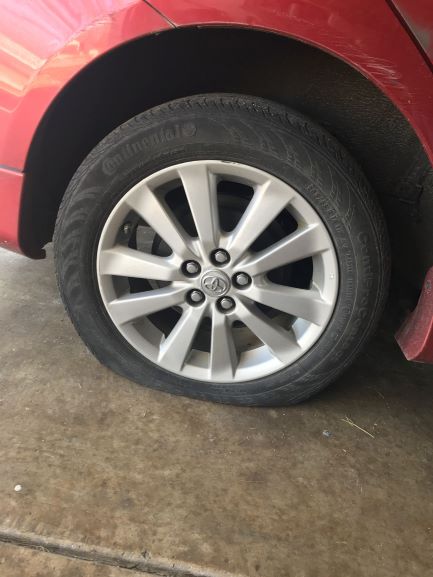
The rear passenger side tire was completely flat! If the warning light hadn’t turned on, I absolutely would have driven on that flat tire. Upon further inspection, it turns out there was a screw buried deep in my tire. I have no idea how long the screw was lodged there, because to be honest, I never remember to check my tire pressure until that light turns on. Clearly, my method of jumping in the car and heading out without much thought isn’t very smart or safe. For Car Care Month, here are some steps we can all take before we hit the road:
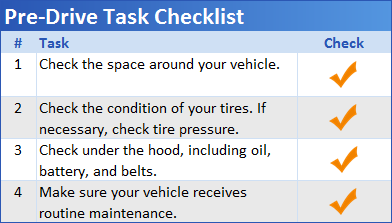
1. Check the space around your vehicle.
The first step is to check around the vehicle as you approach it. If you park in a garage, open the garage door before your check around to help avoid surprises once you open that door. Look around the outside of your vehicle for sharp items on the ground, such as broken glass (from car windows, lights, etc.), nails or screws (like the one that found its way into my tire!), or other debris that could interfere with movement or puncture your tires.
2. Check the condition of your tires.
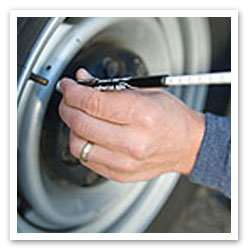
When you check the space around your vehicle, make sure to check the condition of your tires. I will definitely be checking my tires before getting in the car from now on! Look for obvious signs of distress like tread wear, damage, or bars showing. Search for bald spots and cuffing (uneven wear on the inside or outside tread areas), as well as cuts, stones, metal fragments or other damage. Make sure your tires are safe and whole before you drive away on them. Make sure you check the tire pressure regularly. Incorrect tire pressure will compromise cornering, braking and stability.
3. Check under the hood, including oil, battery, and belts.
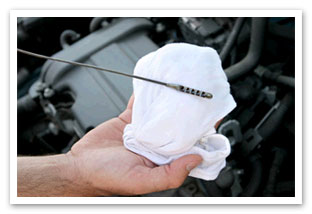
I’m not saying we should all become vehicle mechanics, but checking your vehicle’s coolant, brake fluid, and wiper fluid are easy checks you can do visually. They are each in a see-through container under the hood, so you can just look to see if they’re full enough.
Checking your oil requires a little more work, but you can still do it on your own. You can check it every couple of weeks at home, or simply check it while gassing up. To check your oil, make sure the car is turned off. Pop the hood and pull out the oil stick. Wipe off the oil on the stick with a paper towel or spare rag, and then re-insert it into the oil pan. Remove it once more and look closely for the oil line. The stick should be clearly marked to show what your oil level should be. If your oil is below the fill or add line, add oil. If you do need to add oil, make sure you are adding the correct type. Your vehicle’s owner’s manual should list what type of oil the automaker recommends.
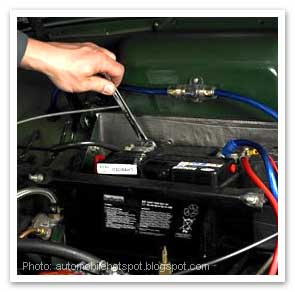
Check your battery for excessive corrosion around the terminals. Make sure your engine’s belts aren’t too loose, and that they’re not cracked or fraying. If you ever hear your engine make a screeching or chirping sound, it might be the sign of a worn belt. Performing these checks on your own will help you know when to get the appropriate professional vehicle maintenance you need.
4. Make sure your vehicle receives routine maintenance.
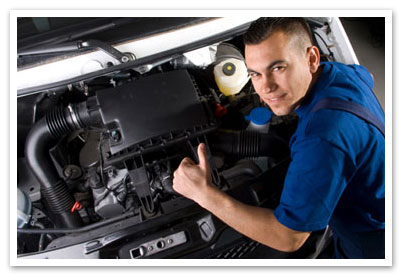
Below is a quick rundown of what you should check on your vehicle and when. These are just general guidelines. Make sure to check your vehicle’s owner’s manual for a specific maintenance schedule based on the make and model of your vehicle.
Weekly Self-Checks:
- Tire pressure and tire condition
- Headlights, tail lights and turn signals
- Emergency lights and markers
- Emergency kit
- Windshield wiper blades, operation, and washer fluid
- Heating, Ventilation, and Air Conditioning (HVAC)
- Safety warning lights (brake, ABS, air bag, seat belts)
- Lap/shoulder belts and seat latches for wear and smooth function
Self-Check Every 1-2 Months:
- All interior and exterior lights
- Engine oil level
- Engine coolant level
Have Professionally Checked Every 3,000-5,000 Miles:
- Oil change/filter replacement
- Tire rotation/balance
Have Professionally Checked Every 15,000 Miles:
- Automatic transmission fluid level
- Brake pads/shoes/rotors/drums, brake lines, hoses and parking brake system
- Engine cooling system
- Steering linkage, suspension and, if equipped, drive shaft and ball joints
- Cabin air filter replacement (if equipped)
Have Professionally Checked Every 30,000 Miles:
- Exhaust system and heat shield
- Engine air filter and fuel filter replacement
- Accessory drive belts
- Automatic transmission/transaxle service (if equipped)
This Car Care Month, take the time to give your car the proper attention it needs in order to function correctly. Hopefully these steps help you as much as they’ve been helping me lately!
Looking for more useful tips like the ones in this post? Consider taking one of our online courses! Check out our website for more information on the driving courses we provide in your state!
April is Car Care Month! First, a quick story. A few weeks ago, I hopped in my car to drive across town. I buckled up, turned the car on, and was about to shift to reverse, business as usual, when I noticed a new alert illuminated on my dashboard: the tire pressure light was on. At first, I debated ignoring the light. After all, I had places to be. I didn’t have time to check my tire pressure! After a moment’s debate, I turned my car off and got out to check the tires. To my surprise, here’s what I saw: